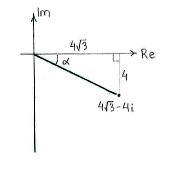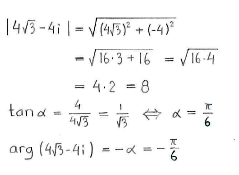Lösung 3.3:1c
Aus Online Mathematik Brückenkurs 2
K |
|||
| Zeile 1: | Zeile 1: | ||
| - | The calculation follows a fairly set pattern. We write the number | + | The calculation follows a fairly set pattern. We write the number <math>4\sqrt{3}-4i</math> in polar form and then use de Moivre's formula. |
| - | <math>4\sqrt{3}-4i</math> | + | |
| - | in polar form and then use de Moivre's formula. | + | |
| - | + | ||
| - | + | ||
| - | + | ||
| + | <center>[[Image:3_3_1_c.gif]] [[Image:3_3_1_c_text.gif]]</center> | ||
This gives | This gives | ||
| - | + | {{Displayed math||<math>4\sqrt{3}-4i = 8\Bigl(\cos\Bigl(-\frac{\pi}{6}\Bigr) + i\sin\Bigl(-\frac{\pi}{6}\Bigr)\Bigr)</math>}} | |
| - | <math>4\sqrt{3}-4i=8\ | + | |
| - | + | ||
and then we get, on using de Moivre's formula, | and then we get, on using de Moivre's formula, | ||
| - | + | {{Displayed math||<math>\begin{align} | |
| - | <math>\begin{align} | + | \bigl(4\sqrt{3}-4i\bigr)^{22} |
| - | + | &= 8^{22}\Bigl(\cos\Bigl(22\cdot\Bigl(-\frac{\pi}{6}\Bigr)\Bigr) + i\sin\Bigl(22\cdot\Bigl(-\frac{\pi}{6}\Bigr)\Bigr)\Bigr)\\[5pt] | |
| - | & =\ | + | &= \bigl(2^3\bigr)^{22}\Bigl(\cos\Bigl(-\frac{11\pi}{3}\Bigr) + i\sin\Bigl(-\frac{11\pi}{3}\Bigr)\Bigr)\\[5pt] |
| - | & =2^{3\ | + | &= 2^{3\cdot 22}\Bigl(\cos\Bigl(-\frac{12\pi -\pi }{3}\Bigr) + i\sin\Bigl(-\frac{12\pi -\pi}{3}\Bigr)\Bigr)\\[5pt] |
| - | & =2^{66}\ | + | &= 2^{66}\Bigl(\cos\Bigl(-4\pi+\frac{\pi}{3}\Bigr) + i\sin\Bigl(-4\pi+\frac{\pi}{3} \Bigr)\Bigr)\\[5pt] |
| - | & =2^{66}\ | + | &= 2^{66}\Bigl(\cos\frac{\pi}{3} + i\sin\frac{\pi}{3}\Bigr)\\[5pt] |
| - | & =2^{66}\ | + | &= 2^{66}\Bigl(\frac{1}{2} + i\frac{\sqrt{3}}{2}\Bigr)\\[5pt] |
| - | \end{align}</math> | + | &= 2^{65}(1+i\sqrt{3}\,)\,\textrm{.} |
| + | \end{align}</math>}} | ||
Version vom 09:06, 30. Okt. 2008
The calculation follows a fairly set pattern. We write the number \displaystyle 4\sqrt{3}-4i in polar form and then use de Moivre's formula.


This gives
| \displaystyle 4\sqrt{3}-4i = 8\Bigl(\cos\Bigl(-\frac{\pi}{6}\Bigr) + i\sin\Bigl(-\frac{\pi}{6}\Bigr)\Bigr) |
and then we get, on using de Moivre's formula,
| \displaystyle \begin{align}
\bigl(4\sqrt{3}-4i\bigr)^{22} &= 8^{22}\Bigl(\cos\Bigl(22\cdot\Bigl(-\frac{\pi}{6}\Bigr)\Bigr) + i\sin\Bigl(22\cdot\Bigl(-\frac{\pi}{6}\Bigr)\Bigr)\Bigr)\\[5pt] &= \bigl(2^3\bigr)^{22}\Bigl(\cos\Bigl(-\frac{11\pi}{3}\Bigr) + i\sin\Bigl(-\frac{11\pi}{3}\Bigr)\Bigr)\\[5pt] &= 2^{3\cdot 22}\Bigl(\cos\Bigl(-\frac{12\pi -\pi }{3}\Bigr) + i\sin\Bigl(-\frac{12\pi -\pi}{3}\Bigr)\Bigr)\\[5pt] &= 2^{66}\Bigl(\cos\Bigl(-4\pi+\frac{\pi}{3}\Bigr) + i\sin\Bigl(-4\pi+\frac{\pi}{3} \Bigr)\Bigr)\\[5pt] &= 2^{66}\Bigl(\cos\frac{\pi}{3} + i\sin\frac{\pi}{3}\Bigr)\\[5pt] &= 2^{66}\Bigl(\frac{1}{2} + i\frac{\sqrt{3}}{2}\Bigr)\\[5pt] &= 2^{65}(1+i\sqrt{3}\,)\,\textrm{.} \end{align} |
